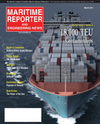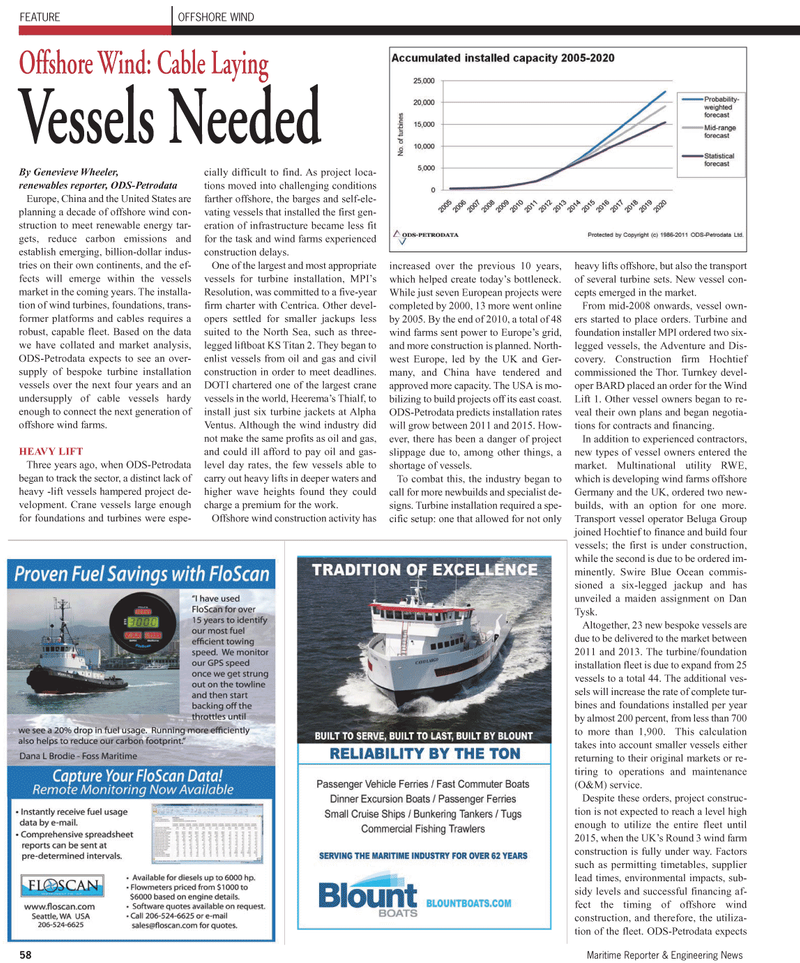
Page 58: of Maritime Reporter Magazine (March 2011)
Ship Repair & Conversion
Read this page in Pdf, Flash or Html5 edition of March 2011 Maritime Reporter Magazine
By Genevieve Wheeler, renewables reporter, ODS-Petrodata
Europe, China and the United States are planning a decade of offshore wind con- struction to meet renewable energy tar- gets, reduce carbon emissions and establish emerging, billion-dollar indus- tries on their own continents, and the ef- fects will emerge within the vessels market in the coming years. The installa- tion of wind turbines, foundations, trans- former platforms and cables requires a robust, capable fleet. Based on the data we have collated and market analysis,
ODS-Petrodata expects to see an over- supply of bespoke turbine installation vessels over the next four years and an undersupply of cable vessels hardy enough to connect the next generation of offshore wind farms.
HEAVY LIFT
Three years ago, when ODS-Petrodata began to track the sector, a distinct lack of heavy -lift vessels hampered project de- velopment. Crane vessels large enough for foundations and turbines were espe- cially difficult to find. As project loca- tions moved into challenging conditions farther offshore, the barges and self-ele- vating vessels that installed the first gen- eration of infrastructure became less fit for the task and wind farms experienced construction delays.
One of the largest and most appropriate vessels for turbine installation, MPI’s
Resolution, was committed to a five-year firm charter with Centrica. Other devel- opers settled for smaller jackups less suited to the North Sea, such as three- legged liftboat KS Titan 2. They began to enlist vessels from oil and gas and civil construction in order to meet deadlines.
DOTI chartered one of the largest crane vessels in the world, Heerema’s Thialf, to install just six turbine jackets at Alpha
Ventus. Although the wind industry did not make the same profits as oil and gas, and could ill afford to pay oil and gas- level day rates, the few vessels able to carry out heavy lifts in deeper waters and higher wave heights found they could charge a premium for the work.
Offshore wind construction activity has increased over the previous 10 years, which helped create today’s bottleneck.
While just seven European projects were completed by 2000, 13 more went online by 2005. By the end of 2010, a total of 48 wind farms sent power to Europe’s grid, and more construction is planned. North- west Europe, led by the UK and Ger- many, and China have tendered and approved more capacity. The USA is mo- bilizing to build projects off its east coast.
ODS-Petrodata predicts installation rates will grow between 2011 and 2015. How- ever, there has been a danger of project slippage due to, among other things, a shortage of vessels.
To combat this, the industry began to call for more newbuilds and specialist de- signs. Turbine installation required a spe- cific setup: one that allowed for not only heavy lifts offshore, but also the transport of several turbine sets. New vessel con- cepts emerged in the market.
From mid-2008 onwards, vessel own- ers started to place orders. Turbine and foundation installer MPI ordered two six- legged vessels, the Adventure and Dis- covery. Construction firm Hochtief commissioned the Thor. Turnkey devel- oper BARD placed an order for the Wind
Lift 1. Other vessel owners began to re- veal their own plans and began negotia- tions for contracts and financing.
In addition to experienced contractors, new types of vessel owners entered the market. Multinational utility RWE, which is developing wind farms offshore
Germany and the UK, ordered two new- builds, with an option for one more.
Transport vessel operator Beluga Group joined Hochtief to finance and build four vessels; the first is under construction, while the second is due to be ordered im- minently. Swire Blue Ocean commis- sioned a six-legged jackup and has unveiled a maiden assignment on Dan
Tysk.
Altogether, 23 new bespoke vessels are due to be delivered to the market between 2011 and 2013. The turbine/foundation installation fleet is due to expand from 25 vessels to a total 44. The additional ves- sels will increase the rate of complete tur- bines and foundations installed per year by almost 200 percent, from less than 700 to more than 1,900. This calculation takes into account smaller vessels either returning to their original markets or re- tiring to operations and maintenance (O&M) service.
Despite these orders, project construc- tion is not expected to reach a level high enough to utilize the entire fleet until 2015, when the UK’s Round 3 wind farm construction is fully under way. Factors such as permitting timetables, supplier lead times, environmental impacts, sub- sidy levels and successful financing af- fect the timing of offshore wind construction, and therefore, the utiliza- tion of the fleet. ODS-Petrodata expects 58 Maritime Reporter & Engineering News
FEATURE OFFSHORE WIND
Offshore Wind: Cable Laying
Vessels Needed

 57
57

 59
59
